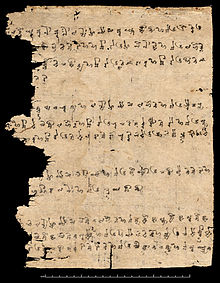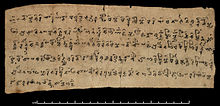| Revision as of 06:23, 24 July 2014 editMonkbot (talk | contribs)Bots3,695,952 editsm →Further reading: Task 5: Fix CS1 deprecated coauthor parameter errors← Previous edit | Revision as of 18:55, 31 August 2014 edit undoKervani (talk | contribs)15 edits →HistoryNext edit → | ||
| Line 36: | Line 36: | ||
| {{Main|Saka}} | {{Main|Saka}} | ||
| The two known dialects of Saka are associated with a movement of ] people. No invasion of the region is recorded in Chinese records and one theory is that two tribes of Saka, speaking the dialects, settled in the region in about 200 BC before the Chinese accounts commence.<ref>{{cite journal|last=Bailey|first=H W|title=The Ancient Kingdom of Khotan|journal=British Institute of Persian Studies|year=1970|volume=8|pages=68}}</ref> | The two known dialects of Saka are associated with a movement of ] people. No invasion of the region is recorded in Chinese records and one theory is that two tribes of Saka, speaking the dialects, settled in the region in about 200 BC before the Chinese accounts commence.<ref>{{cite journal|last=Bailey|first=H W|title=The Ancient Kingdom of Khotan|journal=British Institute of Persian Studies|year=1970|volume=8|pages=68}}</ref> | ||
| It is evident that many of the Saka have spoken Iranian languages, but is certain that the cultural characteristics are represented by other ethnic and linguistic groups as well.<ref name="Fischer">Jürgen Paul: Pp.57</ref> It is not clear whether the Saka-Scythian confederation also consisted of groups who, i.e., didn't spoke an Iranian language.<ref name="Fischer"/> | |||
| ==Classification== | ==Classification== | ||
Revision as of 18:55, 31 August 2014
For the Northern Turkic language spoken in Sakha Republic, Russian Far East, see Sakha language. Not to be confused with Makhuwa-Saka language or West Saka language.| Saka | |
|---|---|
| Khotanese, Tumshuqese | |
| Native to | Kingdom of Khotan, Tumshuq, Murtuq and Qäshqär |
| Region | Tarim Basin (current China) |
| Ethnicity | Saka |
| Era | ≈200 BCE – ≈1000 CE |
| Language family | Indo-European |
| Dialects |
|
| Writing system | Brahmi, Kharosthi |
| Language codes | |
| ISO 639-2 | kho |
| ISO 639-3 | Either:kho – Khotanesextq – Tumshuqese |
| Linguist List | kho (Khotanese) |
xtq (Tumshuqese) | |



(Eastern) Saka or Sakan is a variety of Eastern Iranian languages, attested from the ancient Buddhist kingdoms of Khotan and Tumshuq in the Tarim Basin, in what in now southern Xinjiang, China. It is a Middle Iranian language. The two kingdoms differed in dialect, their speech known as Khotanese and Tumshuqese.
Documents on wood and paper were written in modified Brahmi script with the addition of extra characters over time and unusual conjuncts such as ys for z. The documents date from the fourth to the eleventh century. Tumshuqese was more archaic than Khotanese, but it is much less understood because it appears in fewer manuscripts compared to Khotanese. Both dialects share features with modern Pashto and Wakhi. The language was known as "Hvatanai" in contemporary documents. Many Prakrit terms were borrowed from Khotanese into the Tocharian languages.
History
Main article: SakaThe two known dialects of Saka are associated with a movement of Scythian people. No invasion of the region is recorded in Chinese records and one theory is that two tribes of Saka, speaking the dialects, settled in the region in about 200 BC before the Chinese accounts commence. It is evident that many of the Saka have spoken Iranian languages, but is certain that the cultural characteristics are represented by other ethnic and linguistic groups as well. It is not clear whether the Saka-Scythian confederation also consisted of groups who, i.e., didn't spoke an Iranian language.
Classification
Khotanese and Tumshuqese are closely related Eastern Iranian languages.
Texts
Other than an inscription from Issyk Kurgan that it is tentatively identified as Khotanese (though written in Kharoshthi), all of the surviving documents originate from Khotan or Tumshuq. Khotanese is attested from over 2,300 texts preserved among the Dunhuang manuscripts, as opposed to just 15 texts in Tumshuqese. These were deciphered by Harold Bailey. The earliest texts, from the fourth century, are mostly religious documents. There were several Buddhist monasteries (vihara) in Khotan and Buddhist translations are common at all periods of the documents. There are many reports to the royal court (called haṣḍa aurāsa) which are of historical importance, as well as private documents. An example of a document is Or.6400/2.3.
Notes
- Mallory, J.P. "Bronze Age languages of the Tarim Basin" (PDF). Expedition. 52 (3): 44–53. Retrieved 16 March 2013.
- britanica
- Bailey, H W (1970). "The Ancient Kingdom of Khotan". British Institute of Persian Studies. 8: 65–72. doi:10.2307/4299633.
- Masson], [editors, A.H. Dani, V.M. (1992). History of civilizations of Central Asia. Paris: UNESCO. p. 283. ISBN 92-3-103211-9.
{{cite book}}:|first=has generic name (help)CS1 maint: multiple names: authors list (link) - Bailey, H W (December 1939). "The Rama Story in Khotanese". Journal of the American Oriental Society. 59 (4): 460. doi:10.2307/594480.
- Litvinsky 1999: 432
- Bailey, H W (1970). "The Ancient Kingdom of Khotan". British Institute of Persian Studies. 8: 68.
- ^ Jürgen Paul: Neue Fischer Weltgeschichte. 2012. Volume 10. Zentralasien. Pp.57
- Ronald Emmerick, "Khotanese and Tumshuqese", in Gernot Windfurh, ed., The Iranian Languages, Routledge, 2009
- "The Tumshuqese Language". The LINGUIST List. Multitree: A digital library of language relationships. 2009. Retrieved 6 November 2012.
References
Sources
International Dunhuang Project Bailey, H W (1979) Dictionary of Khotan Saka, Cambridge University Press
Further reading
- Encyclopædia Iranica "Iranian Languages" http://www.iranicaonline.org/articles/central-asia-xiii
- Emmerick, R. E., & Pulleyblank, E. G. (1993). A Chinese text in Central Asian Brahmi script: new evidence for the pronunciation of Late Middle Chinese and Khotanese. Roma: Istituto italiano per il Medio ed Estremo Oriente. (On connections between Chinese and Khotanese, such as loan words and pronunciations)
- Litvinsky, Boris Abramovich; Vorobyova-Desyatovskaya, M.I (1999). "Religions and religious movements". History of civilizations of Central Asia. Motilal Banarsidass. pp. 421–448. ISBN 8120815408.
{{cite conference}}: Unknown parameter|booktitle=ignored (|book-title=suggested) (help)
| Iranian languages | |||||
|---|---|---|---|---|---|
| History | |||||
| Eastern |
| ||||
| Western |
| ||||
| Others |
| ||||
| |||||